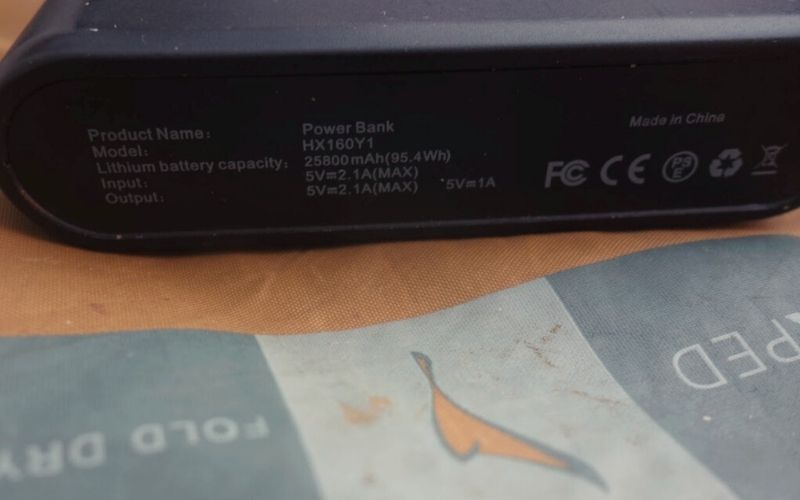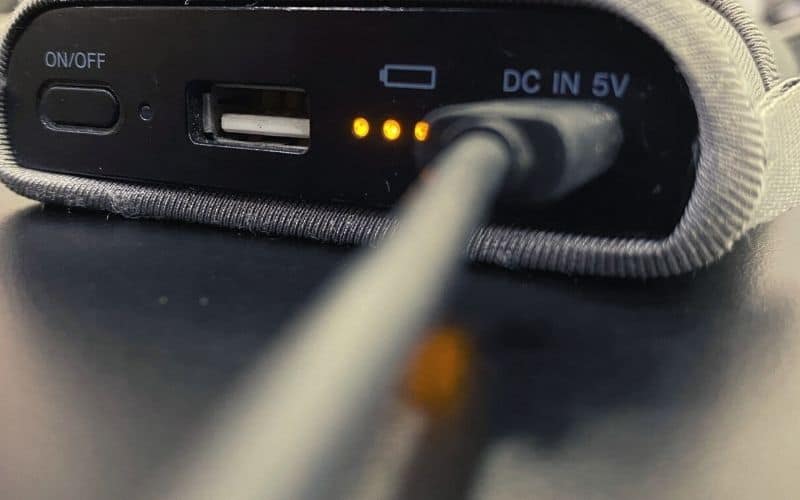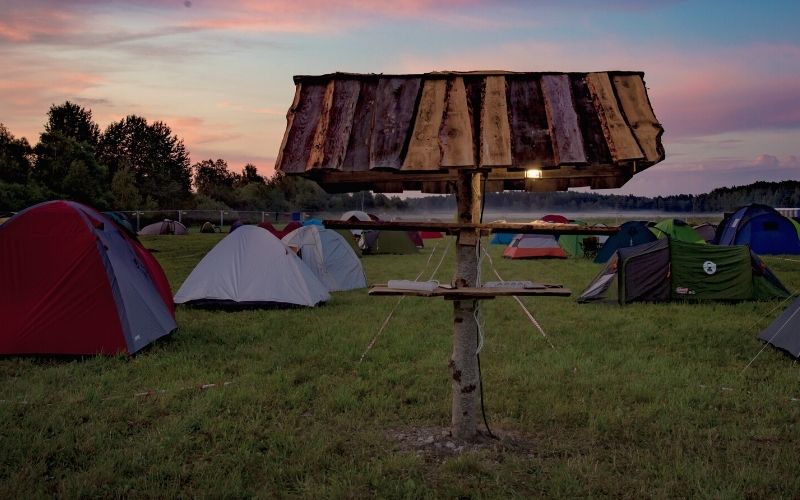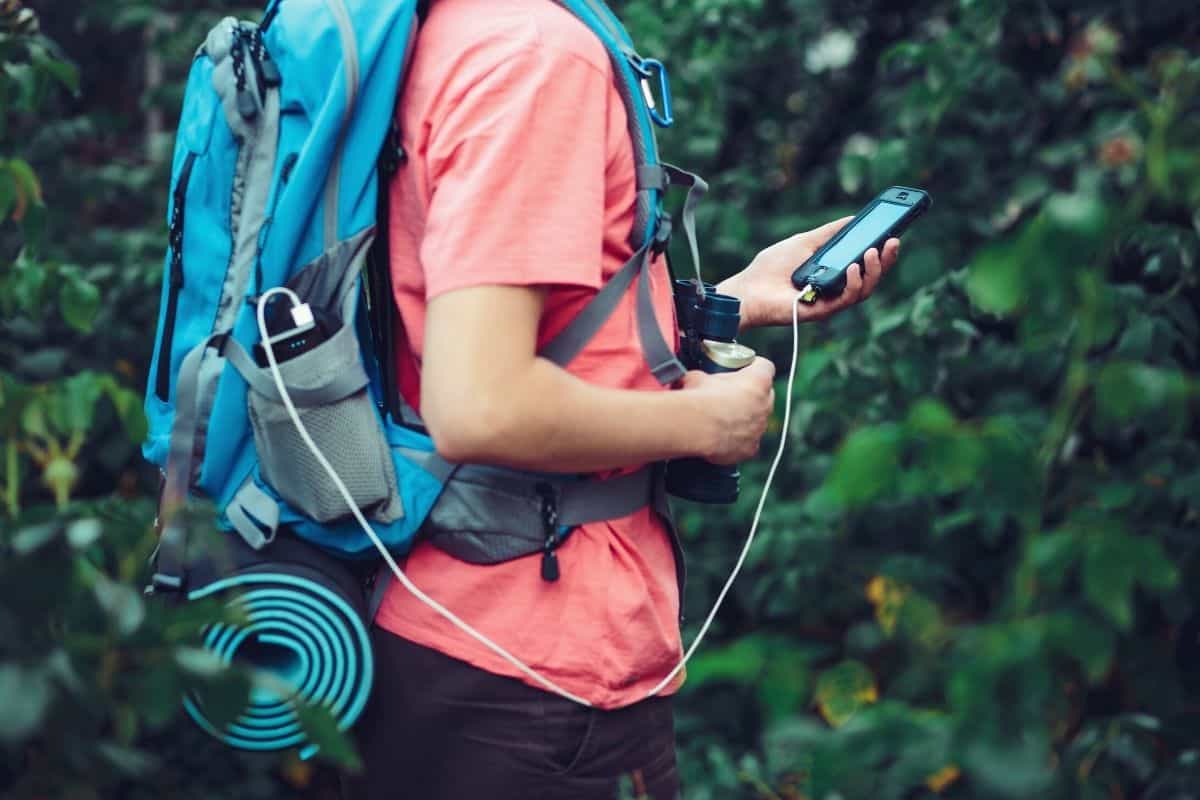These days, it’s hard to find a hiker’s pack that isn’t filled with outdoor tech gadgets. From rechargeable headlamps to smartphones and GPS devices, tech gear brings some home-like comfort to the great outdoors and is indispensable in case of emergencies.
But keeping all that fancy tech stuff powered up in the backcountry is going to require a portable power source. To help you choose the best one for you, we’ve tried and tested many of the most popular power banks out there to come up with this list of our favorite adventure-ready portable chargers. We also cover how to decide which charger is best for you.
Table of Contents
At a Glance: Quick Recommendations
-
Editor’s Choice:
Goal Zero Venture 35
“Versatile, functional, and feature-packed, this durable power bank is our top pick for outdoor adventure.” -
Best Ultralight :
NiteCore LC10
“This lightweight and portable charger makes a good choice for ounce-counting minimalists with low energy requirements.” -
Best Value:
Charmast Power Bank
“A powerful and high-capacity charger with lots of ports for charging multiple gadgets.” -
Most Durable:
MyCharge Adventure 15,000 mAh
“Ideal for backpackers looking for a rugged and waterproof device.” -
Best Budget Power Bank:
The Anker PowerCore 5000
“An inexpensive and ultralight power bank small enough to fit in your pocket.” -
Best Portable Design:
Goal Zero Flip 12
“A sleek, minimalist design and compact size make this perfect for people always on the go.” -
Best for Multiple Devices :
Anker PowerCore+ 26800 PD
“The best fit for campers and backpackers that need plenty of juice for all their devices.” -
Most Versatile:
Anker Astro E1 6700
“The perfect balance between size and capacity at an affordable price.” -
Best High Capacity:
BioLite PD
“Durability and high power output combine in this sleek device.”
What Are The Best Portable Chargers For Backpacking?
We found the Goal Zero Venture 35 to be the best portable charger for backpacking but also highly recommend the following options.
- Goal Zero Venture 35
- NiteCore LC10
- Charmast Power Bank
- MyCharge Adventure 15,000 mAh
- The Anker PowerCore 5000
- Goal Zero Flip 12
- Anker PowerCore+ 26800 PD
- Anker Astro E1 6700
- BioLite PD
Goal Zero Venture 35
Editor’s ChoiceCapacity: 9,600 mAh ⸱ Weight: 10.1 oz. ⸱ Output: 3A ⸱ Ports: 5
The Goal Zero Venture 35 is a versatile device with an excellent weight-to-power ratio and an impressive 35.5-watt-hour battery capacity, fulfilling all our portable power needs and earning it our editor’s choice award.
In terms of output, the Goal Zero offers 9,600 milliamp hours – more than enough to recharge all your backpacking gadgets and devices. Add a solar panel to your kit and you can recharge your bank on the go thanks to its dual charging capabilities (USB and solar).
With a recently upgraded IP rating of IP67, the Goal Zero is now waterproof, dustproof, and always adventure-ready! Another useful perk for campers and backpackers is the Goal Zero’s built-in 50-lumen LED flashlight.
Overall, the Goal Zero Venture 35 is a well-rounded backpacking power bank for anyone looking for a simple and no-fuss solution to powering up their devices in the backcountry.
PROs
- High output
- Many ports
- High IP rating
- Solar panel and regular charging
CONs
- Heavy
- Pricey
Bottom-Line: The perfect option for backpackers looking for the ideal balance of capacity, portability, and rugged durability.
NiteCore LC10
Best UltralightCapacity: 3,400 mAh ⸱ Weight: 0.98 oz. ⸱ Output: 1A ⸱ Ports: 1
The NiteCore LC10 is an ultralight three-in-one portable battery pack, flashlight, and backup light, all in one compact case. Weighing in at an incredibly light 0.98oz, it’s our top pick for backpacking minimalists who prioritize saving every ounce.
On top of being impressively light weight and portable, the NiteCore adds a few other handy features into the mix. It’s got an integrated USB input and output port along with a built-in lightning adapter for Apple devices. As an added safety feature, charging protection automatically disconnects your devices upon charging completion.
While it’s true the NiteCore doesn’t offer a tremendous amount of juice, it remains an affordable and ultralight battery bank suitable for weekend warriors and day-trippers.
PROs
- Price
- Lightweight power bank
- Multiple functions
- Dual output ports
CONs
- Low output
- Only 1 port
Bottom-Line: A highly functional and lightweight choice for minimalist backpackers. The smallest power bank on our list.
Charmast Power Bank
Best ValueCapacity: 26,800 mAh ⸱ Weight: 15.2 oz. ⸱ Output: 4A ⸱ Ports: 4
The Charmast Power Bank offers incredible value for money.
It’s a high-capacity battery and high-output charger with a sleek and pocket-friendly design that resembles a smartphone. Four ports allow you to charge multiple devices simultaneously while LED indicator lights let you know the exact charge remaining.
While the Chamast is up there with the Anker PowerCore+ 26800 PD for the highest capacity charger on our list, it’s lighter and less expensive. You’ll also enjoy high-speed charging through both a USB-C cable or micro USB input.
PROs
- High capacity and output
- Many ports
- 12-month warranty
- LED indicator light
CONs
- Heavy
Bottom-Line: If you’re willing to carry the extra weight, the Charmast is the ultimate high-capacity solution for charging multiple devices.
MyCharge Adventure 15,000 mAh
Most DurableCapacity: 15,000 mAh ⸱ Weight: 12 oz. ⸱ Output: 2.4A ⸱ Ports: 2
The incredibly durable 15,000 mAh MyCharge Adventure is a heavy-duty, drop-resistant, and weatherproof power bank, ideal for hikers, backpackers, and campers who often push their gear to its limits.
With its small, compact design and high portability, the MyCharge is the ultimate outdoor companion. Thanks to a waterproof case and rubberized finish, you’ll never have to worry about the weather forecast or dirt and debris damaging the battery pack. A convenient, built-in carabiner lets you clip the device right to your pack for easy access.
With a 2.4A output, you can fully recharge a phone battery five times from one full charge, making it a suitable choice for multi-day backpacking or camping trips.
PROs
- High IP rating
- Built-in carabiner clip
- Rubberized finish
CONs
- Heavy
Bottom-Line: A heavy-duty, backpacking power bank capable of handling extreme weather conditions.
The Anker PowerCore 5000
Best BudgetCapacity: 5,000 mAh ⸱ Weight: 4.8 oz. ⸱ Output: 2A ⸱ Ports: 1
The Anker PowerCore 5000 is an excellent choice for budget-conscious backpackers. With fast charging and recharging speeds, along with a sleek and portable design, this compact power bank delivers top-notch performance at an affordable price.
Due to its low output, the Anker PowerCore may not be the best choice for multi-day adventurers loaded up with energy-guzzling gadgets. But if you’re heading into the backcountry with just a smartphone, this device is a great, affordable, and highly portable companion.
PROs
- Price
- Weight
- Quick charging time
- 18-month warranty
CONs
- Only 1 port
Bottom-Line: An affordable yet functional device with an impressive 18-month warranty.
Goal Zero Flip 12
Best Portable DesignCapacity: 3,350 mAh ⸱ Weight: 2.5 oz. ⸱ Output: 1A ⸱ Ports: 1
Thanks to the Goal Zero Flip 12’s slim profile, metal outer casing, and compact size, this battery bank wins our top spot for best portable design.
Another outstanding feature is the fact that this handy device can be conveniently charged through either its USB port or through a solar panel. Pair it with most modern solar panels and you’ll find it fully charged in just 3 hours.
While the Goal Zero Flip does have one of the lowest outputs on our list, you’ll still get one full charge for most smartphones. It also ties with NiteCore as the most affordable option on our list.
PROs
- Affordable
- Ultralight
- Solar charger
CONs
- Low capacity
- Only 1 port
Bottom-Line: A good choice for backpackers looking for a portable and solar-ready bank for powering their smartphone.
Anker PowerCore+ 26800 PD
Best for Multiple DevicesCapacity: 26,800 mAh ⸱ Weight: 25.6 oz. ⸱ Output: 2.25A ⸱ Ports: 3
The Anker PowerCore+ 26800 PD is our top choice for backpacking when you need to charge multiple devices simultaneously.
To start with, it offers one of the highest battery capacities on our list alongside the Charmast. Unlike most power banks, all that extra power will allow you to charge big devices like laptops and tablets.
All that power comes at a cost in both weight and $, as the Anker PowerCore is one of the priciest and bulkiest battery packs on our list. But if you’re desperate to keep multiple, energy-hungry devices charged up while out on your adventures, there’s no better choice for a backpacking power bank.
PROs
- High capacity
- Enough power to charge a laptop
- 18-month warranty
- Can charge two devices at the same time
- USB C port
CONs
- Heavy
- Expensive
Bottom-Line: The Anker PowerCore is the ideal choice for backpackers with multiple gadgets to charge.
Anker Astro E1 6700
Most VersatileCapacity: 6,700 mAh ⸱ Weight: 4.4 oz. ⸱ Output: 2A ⸱ Ports: 1
The versatile Anker Astro E1 6700 offers the durability and top-notch performance of the Anker PowerCore+ 26800 but at a fifth of the weight and at a considerably lower price.
You’ll indeed be sacrificing a lot of the juice that makes the Anker PowerCore+ 26800 PD so powerful, but if you’ve only got 1 or 2 small gadgets to charge, the Anker Astro becomes the obvious choice.
The Anker Astro also has a few features that set it apart in its own right. Its light weight and compact size make it perfect for carrying in your pocket, while a smart USB port allows you to charge most devices at full speed (2 amps). Conveniently, you’ll find the necessary micro USB cable right in the box.
PROs
- Affordable
- Lightweight
- 18-month warranty
- Included micro USB cable
CONs
- Not waterproof
- Only 1 port
Bottom-Line: A no-fuss, small power bank for backpackers looking for a simple solution for charging small gadgets.
BioLite PD
Best High CapacityCapacity: 20,000 mAh ⸱ Weight: 16.4 oz. ⸱ Output: – ⸱ Ports: 3
The feature-packed BioLite PD is our favorite high capacity power bank for backpacking.
With a 20,000 mPh battery capacity, you’ll have plenty of juice for charging up all your gear (that’s roughly 4–5 full smartphone charges!). In addition to its impressive output, this backpacking power bank provides several ports, 2 x USB-A quick-charge out ports and a USB-C in/out port allowing you to charge up to three devices at once.
If you’re looking for durability and portability, it’s hard to beat the sleek design and ruggedness of the BioLite.
PROs
- High capacity
- Multiple ports
- Durable
- Rapid charging
CONs
- Heavy
Bottom-Line: A high-capacity device with a durable design. Perfect for multi-day camping or backpacking trips.
How to Choose a Backpacking Power Bank?
Keep the features listed below in mind when choosing a lightweight power bank for backpacking.
- mAh-to-Weight Ratio
- Charging Speed
- Number of Outlets
- Waterproofing
- Added Features
mAh-to-Weight Ratio
When backpacking, its critical to consider the mAh-to-weight ratio. Power bank capacity is measured in milliampere-hours (mAh), indicating how much power the bank has to charge other devices. Higher capacity means more devices can be fully charged before the bank depletes, but it also increases size and weight. There is therefore a balance to be struck between power needs and the size/weight you’re comfortable carrying.
For a one-night trip, aim for at least 5000–9,000mAh like the Anker Powercore 5000 (roughly 1 to 2 smartphone charges). These models are usually small enough to conveniently fit into your pocket.
If your trip spans multiple days and you need more power, aim for a bank with an mAh capacity of 20,000+, like the Charmsat or the Anker PowerCore+ 26800 PD. Any bigger and you’ll be adding considerable bulk and weight to your pack.

Charging Speed
For impatient backpackers, you’ll prefer a bank with a fast charging speed, keeping in mind that various ports on power banks may have different charging speeds.
The important thing to remember is that it doesn’t matter how fast your bank charges devices if you don’t match the input and output charging speeds. For instance, if your smartphone has an input of 5V/2A (5 volts and 2 amps), then you need to find a bank with the same output. Otherwise, you won’t be able to charge your devices at full speed.
Battery output is measured in voltage and amperage (here’s an in-depth look at how both work).
Number of Outlets
To charge multiple devices simultaneously, you’ll need a power bank with multiple outlets. Keep in mind when you do this that your portable charger may not provide maximum current to each port.
For many people, one port will be enough. But if you’ve loaded your pack with a number of gadgets and don’t want to take turns charging up your stuff, aim for a bank with more than one port.

Waterproofing
If you frequently explore the backcountry in unpredictable weather, you’ll want to check the waterproofing capabilities of your power bank. All power banks come with an IP (ingress protection) rating which describes how much water, dirt, and debris they can safely tolerate.
If you’re looking for a charging bank that can withstand rough weather, aim for a rating of at least IP67 (like our top pick, the Goal Zero Venture 35, or the MyCharge Adventure).
Added Features
Useful additional features to keep an eye out for in a power bank are pass-through and wireless charging.
Pass-through charging means that you can charge a device connected to your battery pack while charging the battery of the bank itself. While this might not be relevant for backpackers who have no means of recharging their power pack, it can be very useful for campground campers.
Wireless charging allows you to skip the cables and charge your devices by laying them on top of the battery. This is an easy way to lighten your pack, although usually, only smartphones are compatible with this technology.

Best Power Banks for Backpacking: The Verdict
If you’re concerned about keeping your gear powered during your next backpacking trip, we recommend the Goal Zero Venture 35 for any hiker, camper, or outdoor adventurer.
What did you think of our list? There are many other power banks for backpacking out there, so do let us know if we forgot your favorite. Feel free to share this list with your friends too!

















































![Anker [Upgraded to 6700mAh] Astro E1 Candy-Bar Sized Ultra Compact Portable Charger, External Battery Power Bank, with High-Speed Charging PowerIQ Technology](https://m.media-amazon.com/images/I/31rRgIzz1DL.jpg)
![Anker [Upgraded to 6700mAh] Astro E1 Candy-Bar Sized Ultra Compact Portable Charger, External Battery Power Bank, with High-Speed Charging PowerIQ Technology](https://m.media-amazon.com/images/I/41au4R-J-aL.jpg)
![Anker [Upgraded to 6700mAh] Astro E1 Candy-Bar Sized Ultra Compact Portable Charger, External Battery Power Bank, with High-Speed Charging PowerIQ Technology](https://m.media-amazon.com/images/I/41iIvGJUAfL.jpg)
![Anker [Upgraded to 6700mAh] Astro E1 Candy-Bar Sized Ultra Compact Portable Charger, External Battery Power Bank, with High-Speed Charging PowerIQ Technology](https://m.media-amazon.com/images/I/41hqpDHrSpL.jpg)
![Anker [Upgraded to 6700mAh] Astro E1 Candy-Bar Sized Ultra Compact Portable Charger, External Battery Power Bank, with High-Speed Charging PowerIQ Technology](https://m.media-amazon.com/images/I/41ofBghx3PL.jpg)
![Anker [Upgraded to 6700mAh] Astro E1 Candy-Bar Sized Ultra Compact Portable Charger, External Battery Power Bank, with High-Speed Charging PowerIQ Technology](https://m.media-amazon.com/images/I/31rRgIzz1DL._SL160_.jpg)
![Anker [Upgraded to 6700mAh] Astro E1 Candy-Bar Sized Ultra Compact Portable Charger, External Battery Power Bank, with High-Speed Charging PowerIQ Technology](https://m.media-amazon.com/images/I/41au4R-J-aL._SL160_.jpg)
![Anker [Upgraded to 6700mAh] Astro E1 Candy-Bar Sized Ultra Compact Portable Charger, External Battery Power Bank, with High-Speed Charging PowerIQ Technology](https://m.media-amazon.com/images/I/41iIvGJUAfL._SL160_.jpg)
![Anker [Upgraded to 6700mAh] Astro E1 Candy-Bar Sized Ultra Compact Portable Charger, External Battery Power Bank, with High-Speed Charging PowerIQ Technology](https://m.media-amazon.com/images/I/41hqpDHrSpL._SL160_.jpg)
![Anker [Upgraded to 6700mAh] Astro E1 Candy-Bar Sized Ultra Compact Portable Charger, External Battery Power Bank, with High-Speed Charging PowerIQ Technology](https://m.media-amazon.com/images/I/41ofBghx3PL._SL160_.jpg)









